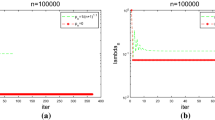Abstract
The convergence rate of the SLP method suggested in Ref. 1 is discussed for composite nondifferentiable optimization problems. A superlinear rate is assured under a growth condition, and it is further strengthened to a quadratic rate if the inside function is twice differentiable. Several sufficient conditions are given which make the growth condition true. These conditions can be relaxed considerably in practical use.
Similar content being viewed by others
References
Zhang, J., Kim, N., andLasdon, L.,An Improved Successive Linear Programming Algorithm, Management Science, Vol. 31, pp. 1312–1331, 1985.
Fletcher, R.,Practical Methods of Optimization, Vol. 2, Wiley, Chichester, England, 1981.
Yuan, Y.,An Example of Only Linear Convergence of Trust Region Algorithms for Nonsmooth Optimization, IMA Journal of Numerical Analysis, Vol. 4, pp. 327–335, 1984.
Sachs, E.,Convergence Rates of Quasi-Newton Algorithms for Some Nonsmooth Optimization Problems, SIAM Journal on Control and Optimization, Vol. 23, pp. 401–418, 1985.
Cromme, L.,Eine Klasse von Verfahren zur Ermittlung Bester Nichtlinear Tschebyscheff Approximationen, Numerische Mathematik, Vol. 25, pp. 447–459, 1976.
Dunn, J. C.,Convergence Rates for Conditional Gradient Sequences Generated by Implicit Steplength Rules, SIAM Journal on Control and Optimization, Vol. 18, pp. 473–487, 1980.
Dunn, J. C.,Newton's Method and the Goldstein Steplength Rule for Constrained Minimization Problems, SIAM Journal on Control and Optimization, Vol. 18, pp. 659–674, 1980.
Clarke, F.,Optimization and Nonsmooth Analysis, Wiley, New York, New York, 1983.
Hiriart-Urruty, J. B.,On Optimality Conditions in Nondifferentiable Programming, Mathematical Programming, Vol. 14, pp. 73–86, 1978.
Bellman, R., Glicksberg, I., andGross, O.,On the Bang-Bang Control Problem, Quarterly of Applied Mathematics, Vol. 14, pp. 11–18, 1956.
Kirk, D.,Optimal Control Theory, Prentice-Hall, Englewood Cliffs, New Jersey, 1970.
Glashoff, K., andGustavson, S. A.,Numerical Treatment of a Parabolic Boundary-Value Control Problem, Journal of Optimization Theory and Applications, Vol. 19, pp. 645–663, 1976.
Sachs, E.,Computation of Bang-Bang Controls and Lower Bounds for a Parabolic Boundary-Value Control Problem, Optimization and Optimal Control, Edited by W. Oetti and K. Ritter, Springer-Verlag, Berlin, Germany, 1976.
Schittkowski, K.,Numerical Solution of a Time-Optimal Parabolic Boundary-Value Control Problem, Journal of Optimization Theory and Applications, Vol. 27, pp. 271–290, 1979.
Author information
Authors and Affiliations
Additional information
Communicated by A. V. Fiacco
This research was supported in part by the National Natural Science Foundation of China.
The author is grateful to Professor E. Sachs, Universität Trier, Trier, West Germany, for his helpful suggestions.
Rights and permissions
About this article
Cite this article
Zhang, J.Z. Superlinear convergence of a trust region-type successive linear programming method. J Optim Theory Appl 61, 295–310 (1989). https://doi.org/10.1007/BF00962802
Issue Date:
DOI: https://doi.org/10.1007/BF00962802




